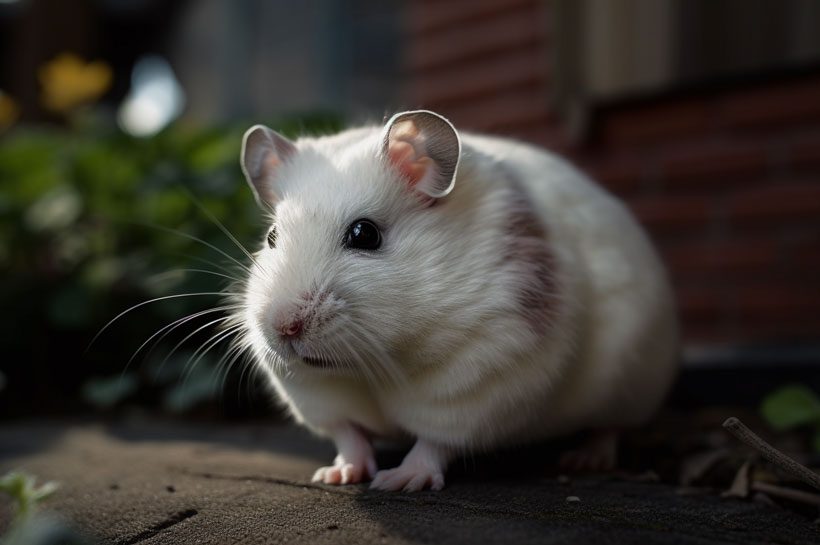How to Find a Lost Hamster?
Losing a pet can be a devastating experience, but it’s essential not to give up hope. In this blog, we’ll be sharing tips on how to find a lost hamster that will increase your chances of a successful reunion.
So, how do you find a lost hamster? The first step is to start searching the immediate surroundings. Check all the hiding spots, and remember to look up. Hamsters can climb, so they may have scaled a wall or perched themselves on a high shelf.
By reading on, you’ll learn how to set up an effective search strategy, tips on creating a scent trail, and ways to entice your hamster out of hiding.
Where Do Hamsters Like to Hide?
Hamsters are known for their love of hiding and burrowing. They typically enjoy hiding in small, dark, and cozy spaces such as tunnels, cardboard boxes, or even their bedding.

They may also seek refuge in their exercise wheels or under furniture. Providing your hamster with plenty of hiding spots in its cage is essential to make them feel safe and secure.
9 Tips for Finding a Lost Hamster
Losing your furry friend can be a terrifying experience as a hamster owner. However, don’t panic just yet. Here are several tips you can follow to find your lost hamster.

1. Check the Cage
Hamsters are excellent at hiding; sometimes, they might only go so far from their cage. Start by thoroughly searching their cage and surrounding areas.
2. Search During the Night
Hamsters are nocturnal animals, which means they are more active at night. Turn off the lights, stay quiet, and listen for any sounds. Your hamster might be moving around or scratching something.
3. Look Under Furniture
Hamsters love to hide under furniture such as beds, couches, or cabinets. Check all the crevices and corners carefully.
4. Leave Treats Around
Place some of your hamster’s favorite treats around the room. Hamsters have an excellent sense of smell, and the smell of their favorite treats might attract them.
5. Use a Flashlight
Hamsters might hide in small, dark areas, making them challenging to spot. Use a flashlight to check all the nooks and crannies in the room.
6. Ask For Help
If you live with someone else, ask for their support. Two pairs of eyes are better than one. Additionally, if you have other pets, such as a dog, they can help locate the hamster.

7. Set up a Trap
You can set up a trap if you need help finding your hamster. Use a box or a container with an entrance and exit hole, place some food inside, and wait.
8. Put up Posters
If your hamster has been missing, consider putting up signs in your neighborhood. Someone might have spotted them and could give you valuable information.
9. Check the Yard
If you have a yard or a garden, check it thoroughly. Your hamster might have escaped outside.
By following these nine tips, you can increase your chances of finding your lost hamster.
Here is a youtube video that gives more information on how to find a lost hamster.
Why Do Hamsters Hide?
Hamsters are known to be burrowing animals, and one of their instincts is to hide. There are several reasons hamsters hide, and understanding them is essential to provide them with the best care possible.
- Firstly, hamsters are prey animals with an instinct to hide from predators. In the wild, they would spend most of their time underground in burrows, feeling safe and protected from predators.
Even in captivity, hamsters still retain this instinct and need a place to hide where they can feel safe and secure.
- Secondly, hiding is also a way hamsters regulate their body temperature. Hamsters are sensitive to temperature changes and need a place to cool down or warm up as needed.

So hiding in a burrow or a hideout provides them a safe and secure place to regulate their body temperature, especially during extreme weather conditions.
- Thirdly, hamsters are known to be territorial animals and need their space. Providing them with a hideout gives them a place to retreat when they feel overwhelmed or stressed.
Hamsters can become aggressive when they feel threatened, and having a place to hide can prevent fights and injuries.
- Lastly, hiding is also a natural behavior for hamsters. It’s part of their instincts and essential to their physical and mental well-being.
Hamsters that don’t have a place to hide can become stressed and anxious, which can lead to health problems.
How Do You Lure Your Lost Hamster?
Hamsters are curious creatures and can be easily baited with the right food or objects. Here are some tips on how to lure a hamster out of hiding.
Food
Hamsters love food and can be easily baited with treats such as fruits, vegetables, and seeds. However, it is essential to remember that not all foods are safe for hamsters.

Some foods, such as chocolate, garlic, and onions, can be toxic to them. Hence, it is vital to research and only offer safe and healthy options.
Toys
Hamsters love to play and explore, so offering toys can be a great bait. Toys like exercise wheels, tunnels, and chew toys can keep them entertained and curious.

Scents
Hamsters have a keen sense of smell and can be attracted to certain scents. Placing vanilla extract or other safe scents near their food or toys can help bait them.
Hide and seek
Hamsters love to hide and explore, so hiding treats or toys in different locations around their habitat can encourage them to come out and search.

Timing
Hamsters are nocturnal animals, so they are most active during the night. Baiting them during the evening or night can increase the chances of success.
Losing your hamster can be a stressful experience, but there are ways to prevent it and tips to help find your pet if they do get lost. Additionally, there are other important topics to consider when caring for your hamster. For example, if you live in a hot climate or are experiencing warm weather, our guide on how to keep hamsters cool provides tips and tricks for keeping your pet comfortable and safe. Furthermore, if you’re concerned about fleas on your hamster, our guide on whether hamsters can get fleas offers valuable information on how to protect your pet. By reading through these guides, you’ll be able to take better care of your hamster and keep them healthy and happy.FAQs
Now check out these frequently asked questions for further information in this regard.
Q: How can I prevent my hamster from getting lost in the future?
Make sure your hamster’s cage is secure and has no holes or gaps from which it can escape. Always supervise your hamster outside its cage, and keep it away from areas where it could get stuck or run.
Additionally, consider microchipping your hamster or adding identification tags to its cage or collar to be easily identified if it gets lost.
Q: How long can a hamster survive without food and water?
Hamsters can survive for several days without food and water, but finding them as soon as possible is important. Dehydration and malnutrition can quickly cause health problems, so it is best to act fast.
Q: How long can a hamster survive on its own if lost?
Hamsters are small and delicate animals that may not survive long if lost. They can stay for a few days without food and water, but their health can quickly deteriorate. So it is essential to find your lost hamster as soon as possible.
Conclusion
In conclusion, finding a lost hamster can be daunting but manageable with the right approach. Start by thoroughly searching your home and surrounding area, using food and scent lures to attract the hamster. It is also essential to inform your neighbors and post flyers in the community.
Likewise, taking preventative measures such as properly securing their habitat and providing identification can also prevent your hamster from getting lost. With patience and persistence, you can successfully find your lost hamster and bring them back home where they belong.




